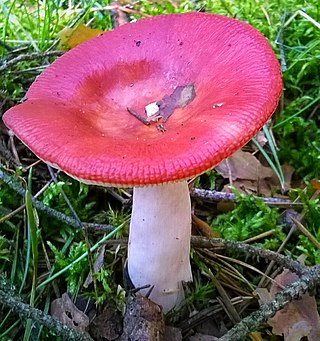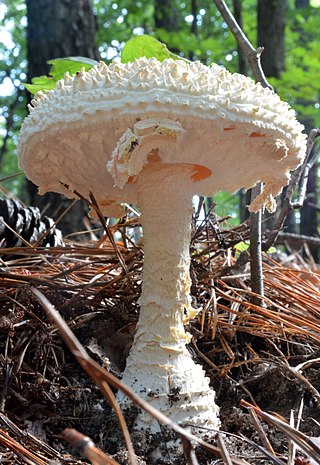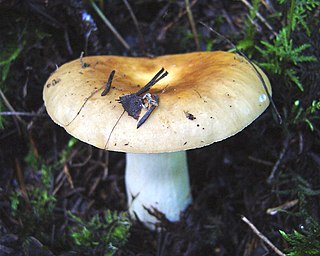
Russula is a very large genus composed of around 750 worldwide species of ectomycorrhizal mushrooms. They are typically common, fairly large, and brightly colored – making them one of the most recognizable genera among mycologists and mushroom collectors. Their distinguishing characteristics include usually brightly coloured caps, a white to dark yellow spore print, brittle, attached gills, an absence of latex, and absence of partial veil or volva tissue on the stem. Microscopically, the genus is characterised by the amyloid ornamented spores and flesh (trama) composed of spherocysts. Members of the related genus Lactarius have similar characteristics but emit a milky latex when their gills are broken. The genus was described by Christian Hendrik Persoon in 1796.

Russula emetica, commonly known as the sickener, emetic russula, or vomiting russula, is a basidiomycete mushroom, and the type species of the genus Russula. It has a red, convex to flat cap up to 8.5 cm (3.3 in) in diameter, with a cuticle that can be peeled off almost to the centre. The gills are white to pale cream, and closely spaced. A smooth white stem measures up to 10.5 cm (4.1 in) long and 2.4 cm (0.9 in) thick. First described in 1774, the mushroom has a wide distribution in the Northern Hemisphere, where it grows on the ground in damp woodlands in a mycorrhizal association with conifers, especially pine.

Russula vesca, known by the common names of bare-toothed Russula or the flirt, is a basidiomycete mushroom of the genus Russula.

Russula virescens is a basidiomycete mushroom of the genus Russula, and is commonly known as the green-cracking russula, the quilted green russula, or the green brittlegill. It can be recognized by its distinctive pale green cap that measures up to 15 cm (6 in) in diameter, the surface of which is covered with darker green angular patches. It has crowded white gills, and a firm, white stipe that is up to 8 cm (3 in) tall and 4 cm (1.6 in) thick. Considered to be one of the best edible mushrooms of the genus Russula, it is especially popular in Spain and China. With a taste that is described variously as mild, nutty, fruity, or sweet, it is cooked by grilling, frying, sautéeing, or eaten raw. Mushrooms are rich in carbohydrates and proteins, with a low fat content.

Russula claroflava, commonly known as the yellow russula, yellow swamp russula or yellow swamp brittlegill, is a basidiomycete mushroom of the genus Russula. It is found in wet places under birch and aspen woodlands across Europe and North America. It has a yellow cap, white gills and stipe and bruises grey. It is mild-tasting and regarded as good to eat.

Russula brevipes is a species of mushroom commonly known as the short-stemmed russula or the stubby brittlegill. It is widespread in North America, and was reported from Pakistan in 2006. The fungus grows in a mycorrhizal association with trees from several genera, including fir, spruce, Douglas-fir, and hemlock. Fruit bodies are white and large, with convex to funnel-shaped caps measuring 7–30 cm (3–12 in) wide set atop a thick stipe up to 8 cm (3 in) long. The gills on the cap underside are closely spaced and sometimes have a faint bluish tint. Spores are roughly spherical, and have a network-like surface dotted with warts.

Russula atropurpurea is an edible member of the genus Russula. It is dark vinaceous or purple, and grows with deciduous, or occasionally coniferous trees. It is commonly called the blackish purple Russula, or the purple brittlegill.

Russula delica is a mushroom that goes by the common name of milk-white brittlegill, and is a member of the genus Russula, all of which are collectively known as brittlegills. It is mostly white, with ochraceous or brownish cap markings, and a short robust stem. It is edible, but poor in taste, and grows in coniferous, broadleaved, or mixed woods. It can be confused with other white Russula species and certain white Lactarius species.

Amanita abrupta, commonly known as the American abrupt-bulbed amanita or the American abrupt-bulbed lepidella, is a possibly toxic species of fungus in the family Amanitaceae. Named for the characteristic shape of its fruit bodies, this white Amanita has a slender stem, a cap covered with conical white warts, and an "abruptly enlarged" swollen base. This terrestrial species grows in mixed woods in eastern North America and eastern Asia, where it is thought to exist in a mycorrhizal relationship with a variety of both coniferous and deciduous tree species.

Hygrophorus subalpinus, commonly known as the subalpine waxycap, is a species of white snowbank fungus in the family Hygrophoraceae. Found in the mountains of western North America, it is found growing on the ground under conifers, usually near snowbanks.

Russula albidula is a species of mushroom in the genus Russula. The species, known in the vernacular as the boring white russula or the whitish brittlegill, is nondescript, with a small or medium dirty white fruit body, and a highly acrid taste. It is found in eastern North America.

Amanita daucipes is a species of fungus in the family Amanitaceae of the mushroom order Agaricales. Found exclusively in North America, the mushroom may be recognized in the field by the medium to large white caps with pale orange tints, and the dense covering of pale orange or reddish-brown powdery conical warts on the cap surface. The mushroom also has a characteristic large bulb at the base of its stem with a blunt short rooting base, whose shape is suggestive of the common names carrot-footed lepidella, carrot-foot amanita, or turnip-foot amanita. The mushroom has a strong odor that has been described variously as "sweet and nauseous", or compared to an old ham bone, or soap. Edibility is unknown for the species, but consumption is generally not recommended due its position in the Amanita subgroup Lepidella, which contains some poisonous members.

Agaricus deserticola, commonly known as the gasteroid agaricus, is a species of fungus in the family Agaricaceae. Found only in southwestern and western North America, A. deserticola is adapted for growth in dry or semi-arid habitats. The fruit bodies are secotioid, meaning the spores are not forcibly discharged, and the cap does not fully expand. Unlike other Agaricus species, A. deserticola does not develop true gills, but rather a convoluted and networked system of spore-producing tissue called a gleba. When the partial veil breaks or pulls away from the stem or the cap splits radially, the blackish-brown gleba is exposed, which allows the spores to be dispersed.

Lactifluus deceptivus, commonly known as the deceiving milkcap, is a common species of fungus in the family Russulaceae. It is found throughout eastern North America on the ground in coniferous forests near hemlock or deciduous forests near oak, and in oak-dominated forests of Costa Rica. It produces large mushrooms with funnel-shaped caps reaching up to 25 cm (9.8 in) in diameter, on top of hard white stems that may reach 4–10 cm (1.6–3.9 in) long and up to 3 cm (1.2 in) thick. The gills are closely spaced together and yellowish-cream in color. When young, the cap is white in all parts, but the depressed center becomes dull brownish in age and breaks up into scales. The edge of the cap has a roll of cottony tissue that collapses as the cap expands. The surface of the stem—especially near the base—has a velvety texture. The mushroom "bleeds" a milky white acrid latex when it is cut or injured. Similar milk-cap species with which L. deceptivus might be confused include Lactifluus piperatus, L. pseudodeceptivus, L. caeruleitinctus, L. subvellereus, Lactarius arcuatus and Lactarius parvulus.

Amanita ravenelii, commonly known as the pinecone lepidella, is a species of fungus in the family Amanitaceae. The whitish fruit bodies are medium to large, with caps up to 17 centimetres wide, and stems up to 25 cm (10 in) long. The cap surface has large warts and the stem has a scaly, bulbous base. The mushrooms have a unique chlorine like odor.

Amanita ceciliae, commonly called snakeskin grisette, strangulated amanita, and the Cecilia's ringless amanita, is a basidiomycete fungus in the genus Amanita. First described in 1854 by Miles Joseph Berkeley and Christopher Edmund Broome, it was given its current name by Cornelis Bas in 1984. It is characterized by bearing a large fruit body with a brown cap 5–12 cm (2.0–4.7 in) across. The cap has charcoal-grey patches, which are easily removable. The stipe is 7–18 cm (2.8–7.1 in) long, white in colour, and there is no ring on it. It is slightly tapered to the top, and has irregular cottony bands girdling the base. The universal veil is grey. Spores are white, spherical in shape, non-amyloid, and measure 10.2–11.7 micrometres. The mushrooms are considered edible, but field guides typically advise caution in selecting them for consumption, due to risks of confusion with similar toxic species. A. ceciliae is found in woods throughout Europe and North America, where it fruits during summer and autumn.

Russula densifolia, commonly known as the crowded russula or the reddening russula, is a species of agaric fungus in the family Russulaceae. It was first described in 1833 and given its current name in 1876. A widespread species, it is found in Asia, Europe, and North America, where it fruits on the ground in mixed and deciduous forests. Fruit bodies (mushrooms) are robust and squat, with caps up to 14.5 cm (5.7 in) in diameter, and stems that are 2–7.5 cm (0.8–3.0 in) long by 1.2–2.5 cm (0.5–1.0 in) thick. The mushrooms are characterized by the red and then black color changes that occur in the flesh when it is bruised, and a relatively thick cap cuticle. Although the mushroom is sold as an edible species in some areas of Asia, it is mild to moderately toxic, and may cause gastrointestinal upset if consumed. Several bioactive compounds have been isolated and identified from the mushroom.

Russula crustosa, commonly known as the crusty russula, is a species of fungus in the family Russulaceae. It is found in Asia and North America.

Hygrophorus russula, commonly known as the pinkmottle woodwax, false russula, or russula-like waxy cap, is a fungus native to North America and Europe.

Russula mustelina, commonly known as the russet brittlegill, is a basidiomycete mushroom of the genus Russula native to Europe and North America. Swedish mycologist Elias Magnus Fries described the species in his 1838 book Epicrisis Systematis Mycologici seu Synopsis Hymenomycetum.



















